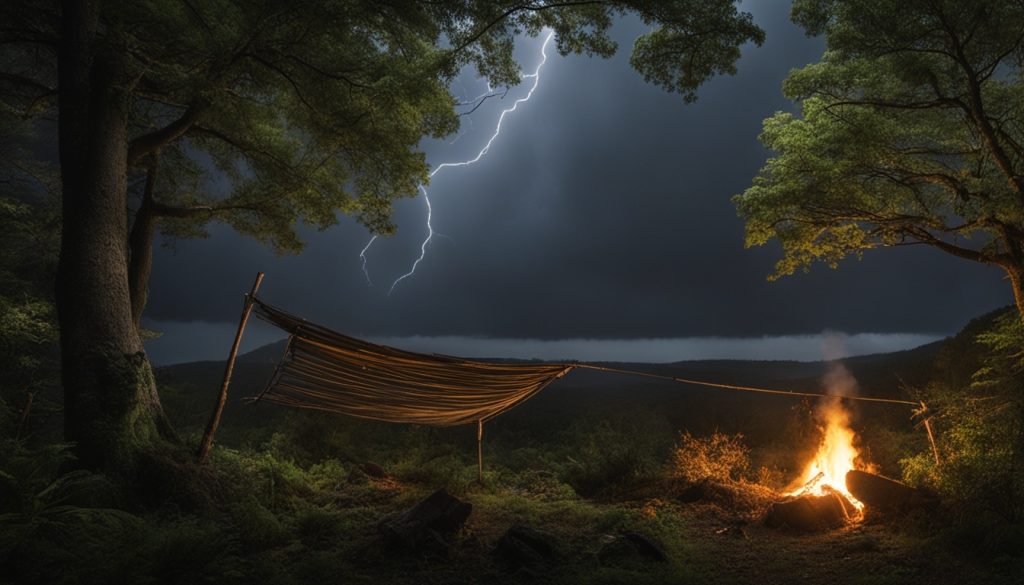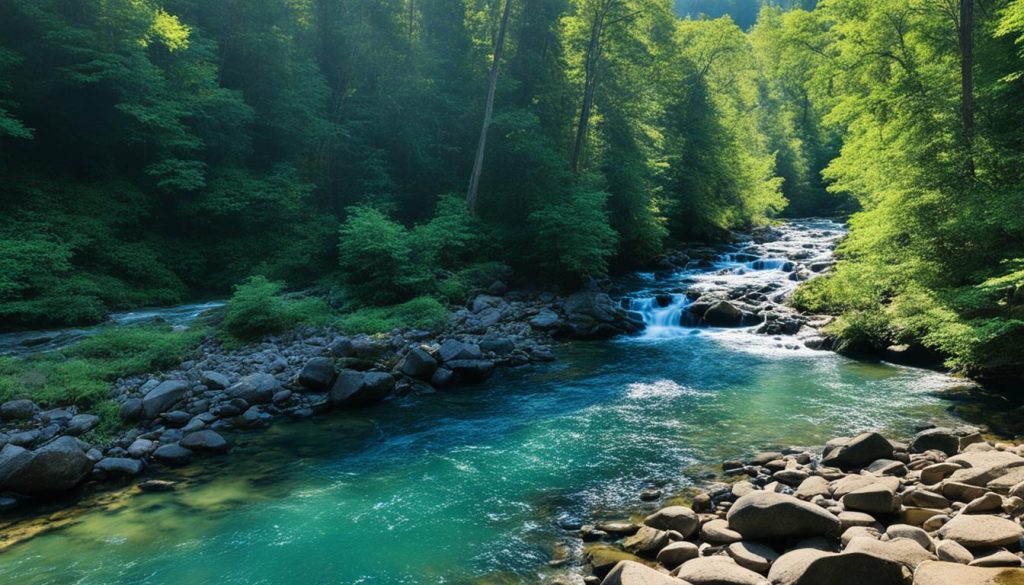Did you know over 570,000 people in the U.S. go camping and backpacking each year? Nature is both beautiful and challenging. It’s crucial for beginners to know the basics of surviving in the wild. Whether it’s a quick camping trip or a longer adventure, being prepared is key for a safe and fun time.
This guide will cover the basics of surviving in the wild for newcomers. We’ll go over important tips and skills for outdoor survival. Topics include building shelters, finding water, starting fires, and hunting for food. After reading, you’ll have the essentials to do well in the wilderness.
Key Takeaways:
- Being self-sufficient in the outdoor environment is crucial for wilderness survival.
- Essential survival skills and techniques are necessary for a safe and enjoyable experience in the wilderness.
- Understanding wilderness safety and being prepared can make all the difference in survival situations.
- This guide will provide you with the knowledge and skills to navigate and thrive in the wilderness.
- From shelter building to water procurement and fire making, we’ll cover all the essentials of wilderness survival for beginners.
The Psychology of Survival: Maintaining a Calm Center
In survival situations, staying calm can save your life. Our mindset is key to facing tough times with strength. We’ll look into survival psychology and how it helps us keep a positive attitude during challenges.
Fear and panic in survival situations hurt our thinking. It’s vital to be calm to make smart choices. A cool head lets us see things clearly and act wisely.
Being positive is a big part of survival psychology. It helps us face challenges with hope and plan better. A good attitude boosts our mood and problem-solving. It makes surviving in the wild more possible.
Experts in wilderness survival share stories that show how important staying calm is. They teach us that being strong and calm helps overcome tough times. Our mental strength in such situations is very powerful.
Remember, maintaining a calm center is not about eradicating fear; it’s about acknowledging fear while still being able to think and act effectively. Embrace the discomfort and uncertainty of the wilderness, and let it fuel your determination to survive.
In wilderness survival, our minds are as crucial as our gear. Even with the best tools, mental strength is what really sees us through. Training our minds is just as important as any physical skill.
You can learn to be calm and positive with practice. Understanding survival psychology helps us prepare for nature’s challenges. It gives us the confidence to face any situation head-on.
Shelter Building: Protecting Yourself from the Elements
Building a shelter in the wild is key to staying safe. A good shelter keeps you warm and dry. It shields you from the cold and other bad weather.
The debris hut is a favorite among survival experts. It’s made by piling up sticks, leaves, and branches. This hut keeps you insulated and dry. It holds in warmth well, even when it’s cold outside.
To make this debris hut, start by laying a foundation of sticks. Then, cover it with lots of leaves and foliage. This makes a sturdy shelter against weather. Pick a location with natural barriers, like rocks or trees. This will make your shelter stand strong.
Key Principles for Shelter Building
- For warmth, use plenty of insulation. Surround your shelter with leaves, moss, or snow.
- Place your shelter away from strong winds and rain. Natural windbreaks or rocks can help.
- Make your shelter cozy. Clear the ground and lay down leaves or branches. A comfortable space can keep your spirits up.
Knowing how to build a shelter is vital in the wild. Remember the basics: insulation, protection, and comfort. They will make sure your shelter is a safe spot to weather the outdoors.
Water Procurement and Purification: Staying Hydrated in the Wild
When it comes to surviving in the wilderness, finding clean water is key. You can find water in rivers, lakes, springs, and more. These sources are crucial for hydration and staying healthy.
Finding Reliable Water Sources:
Finding clean water is vital in the wild. It should be free of contaminants to avoid getting sick. Here are places where you can find safe water:
- Rivers and Streams: Flowing water is often cleaner and safer to drink.
- Lakes and Ponds: These can be good water sources but might need purifying before drinking.
- Springs: Springs often have pure water that is safe to drink without much treatment.
- Rock Depressions: Some rocks can collect rainwater, offering a source of hydration.
Water Purification Methods:
Always purify water, even if it looks clean. Purification kills harmful bacteria and keeps you safe. Here are some great ways to do it:
- Boiling: Boil water for at least a minute to kill germs safely.
- Chemical Tablets: These tablets, like iodine, can make water safer to drink.
- Water Filters: Filters can remove harmful particles, making water cleaner.
- Solar Water Disinfection: Leaving water in the sun for six hours can kill dangerous germs.
Staying Hydrated in Survival Situations:
Staying hydrated in tough times is crucial. Lack of water can cause serious health problems. Here’s how to keep hydrated:
- Drink water often, not just when you’re thirsty.
- Save water by not overworking or getting too hot.
- Use juicy fruits and plants for water in an emergency.
- Check your urine to see if you’re drinking enough.
Knowing how to find and clean water is essential for surviving in the wild. These skills are crucial for staying hydrated and alive outdoors.
Fire Making: Essential for Survival in the Wild
Fire is critical for staying alive in the wild. It brings warmth and cooks food. Also, it purifies water and acts as a base for survival tasks.
Creating and keeping fire requires knowing certain steps. You must understand about fire structures, fuels, and how to start a fire.
Fire Structures
There are different fire building methods. Each has its own perks and suits specific needs. Picking the right structure helps achieve the goal.
For instance, you can use a teepee, lean-to, or log cabin style. They vary in how they hold the fuel and the heat they give off.
Fire Fuels
The type of fuel affects how well your fire burns. Various woods and materials burn at different rates and temperatures.
When looking for firewood, think about dryness and size. Dry hardwoods, such as oak or maple, are great. They burn longer and give off more heat than fresh woods.
Fire-Making Methods
In the wild, you can start a fire in many ways. Using tools like matches is easy. But, you should also know traditional ways in case your tools are lost or break.
Methods like flint and steel or the bow drill require practice. They use friction to create a spark. This spark starts the fire.
Being able to start and keep a fire going is key for survival. You need to know how to manage the fire, add fuel, and control its size.
Maintaining a fire is more than starting it. Keep adding fuel and manage airflow. This will keep your fire burning strong.
Summing up, fire making is a crucial skill in the outdoors. Knowing about different fires, choosing good fuels, and using various methods are important. By getting good at taking care of a fire, you improve your survival chances. This ensures you’re safe and comfortable in the wild.
Finding Food in the Wilderness: Hunter-Gatherer Skills
Being in the wilderness means food becomes a top priority. Our ancestors from long ago found ways to feed themselves. Their skills are still important for surviving in nature today.
Wild plants are a main source of food in the wild. In North America, there are roughly 33 types of edible plants. Dandelions, cattails, and nettles are some. They give vitamins, minerals, and energy to keep you strong.
Hunting, fishing, and trapping are also vital for food. Setting traps, following animal tracks, and fishing are essential skills. They require knowing animal habits and how to use traps and fishing tools.
Knowing about medicinal plants is key too. Some plants can heal you or help with sickness. For example, yarrow, comfrey, and plantain have been used for healing for ages.
“In a wilderness survival scenario, being skilled in wilderness survival food sources, wild edible plants, hunting, fishing, trapping, and medicinal plants is more valuable than any amount of gear you may possess.” – John Smith, Wilderness Survival Expert
While having some supplies is good, skill is most important for survival. It lets you live off the land, no matter where you are. Knowing the wilderness and its food helps you stay fed when you’re out there.
| Wild Edible Plants | Hunting Techniques | Fishing Methods | Trapping Skills | Medicinal Plants |
|---|---|---|---|---|
| Dandelions | Tracking | Rod and Reel | Snare traps | Yarrow |
| Cattails | Bowhunting | Spearfishing | Deadfall traps | Comfrey |
| Nettles | Camouflage techniques | Netting | Pit traps | Plantain |
| … (more wild edible plants) | … (more hunting techniques) | … (more fishing methods) | … (more trapping skills) | … (more medicinal plants) |
Starting a wilderness journey, be sure to know how to find food. Practice hunting, fishing, and learning about medicinal plants. These skills help you survive and do well in the wild.
Wilderness Survival Skills vs. Gear: The Importance of Skills
In the wilderness, the big question is: Are skills or gear more important for survival? Gear is surely helpful, but the real treasure is in the skills you learn. In an actual survival moment, knowing what to do can save your life.
No matter how much gear you have, there might be a time when it’s not there. It could get lost or you might leave it behind by mistake. But your skills are always with you. They can help in any emergency.
Survival is mainly about adapting and thinking outside the box. In the wild, you might face unexpected challenges. Having various skills lets you handle these situations. For example, knowing how to start a fire without matches could be the key to staying warm.
Learning survival skills also makes you feel more in control and self-sufficient. When you know how to find water, build shelter, and hunt for food, you need less from the outside world. This makes you more likely to survive. Plus, it builds your confidence and strength.
| Exposure to Elements | Dehydration | Food Deprivation | Wild Edible Plants | |
|---|---|---|---|---|
| Time Until Fatality | 3 hours | 3 days | 3 weeks | 33 featured in wilderness survival guides |
Yes, having the right gear is good, but skills are what truly keep you alive. Putting time into learning survival techniques prepares you better. It gives you the wisdom to face any survival challenge, with or without gear.
In the end, survival skills stand above gear. They bring self-reliance, quick thinking, and strong willpower. Whether you’re stuck without gear or just love the outdoors, learning survival skills is pivotal and fulfilling.
Conclusion
Exploring the world of wilderness survival shows us its huge value. Learning these skills helps us live a simpler life. And it lets us thrive in the wild, which can be unpredictable and tough.
Wilderness survival is more than just knowing how to survive. It teaches us a deep respect for the world. Being in the wild, we learn about protecting nature and our place in it.
When we learn wilderness survival skills, we get ready for outdoor adventures. But, we also grow to love and respect nature more. So, whether it’s a short course or a long trip into the wild, it changes us. This training brings us closer to nature’s raw beauty.


